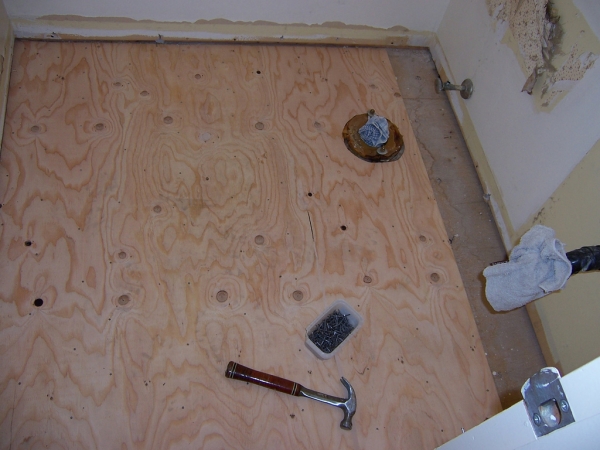Underlayment
Wood based underlayments are panel or sheet materials that are used between a structural subfloor and a finish floor surface. Also known as overlayment, wood panel materials are commonly used under resilient tile or sheet floors. They can also be used under adhered carpet or other nonstructural flooring as well.
 Credit: Flickr | kjdyck | CC 2.0
Credit: Flickr | kjdyck | CC 2.0
Topic Summary
Wood panel underlayments are used to ensure a clean, uniform, smooth substrate that is suitable for adhesion of finish floor materials. They are engineered wood materials that have varying compositions. They include hardboard, particleboard, oriented strand board (OSB) and plywood.
Composed from densely pressed wood fibers, hardboard is difficult to find for use as an underlayment. Some manufacturers recommend against its use under their products. Compressed wood particle materials, such as particleboard and OSB, have good impact resistance. Particleboard is susceptible to water damage and swelling. Use of these products in wet areas (such as kitchens and bathrooms) or over crawlspaces is not recommended; OSB strands expand and contract differently, which could result in an unsightly telegraphing of the underlayment particle texture to the finish floor material surface. Plywood is composed from thin layers of veneer, laid in parallel and adhered together. These engineered materials are typically one-quarter inch (1/4") thick, four foot by eight foot (4'x8') panels. They are available in different thicknesses and lengths up to sixteen feet (16') long. The preferred underlayment for use under resilient flooring is a fully sanded face plywood that is APA graded and stamped with "underlayment" or "plugged crossbands" and has exposure classification of "exposure 1" or "exterior."
A finish floor surface is only as good as the underlayment. Proper preparation of the subfloor and installation of a proper underlayment is essential for a finish floor's performance and appearance, and ensures a valid manufacturer's warranty. Finish floor manufacturers provide recommendations for preparation and installation. Underlayments should be installed in accordance with these recommendations and with industry standards, such as ASTM F1482, "Installation and Preparation of Panel Type Underlayments to Receive Resilient Flooring."
In addition to wood based underlayments, many other types of underlayments are available for specific finish floor surfaces. These types include: foam and rubber pads, plastic, paper and film sheets, fiber-reinforced gypsum panels, poured cementitious materials, cement board, and cork. They ensure good performance and appearance of the finish floor while providing structural support, subfloor leveling, and insulation, and they also serve as moisture and acoustical barriers.

Buildipedia Staff
The Buildipedia research and writing staff consists of dozens of experienced professionals from many sectors of the industry, including architects, designers, contractors, and engineers.
Website: buildipedia.com/


